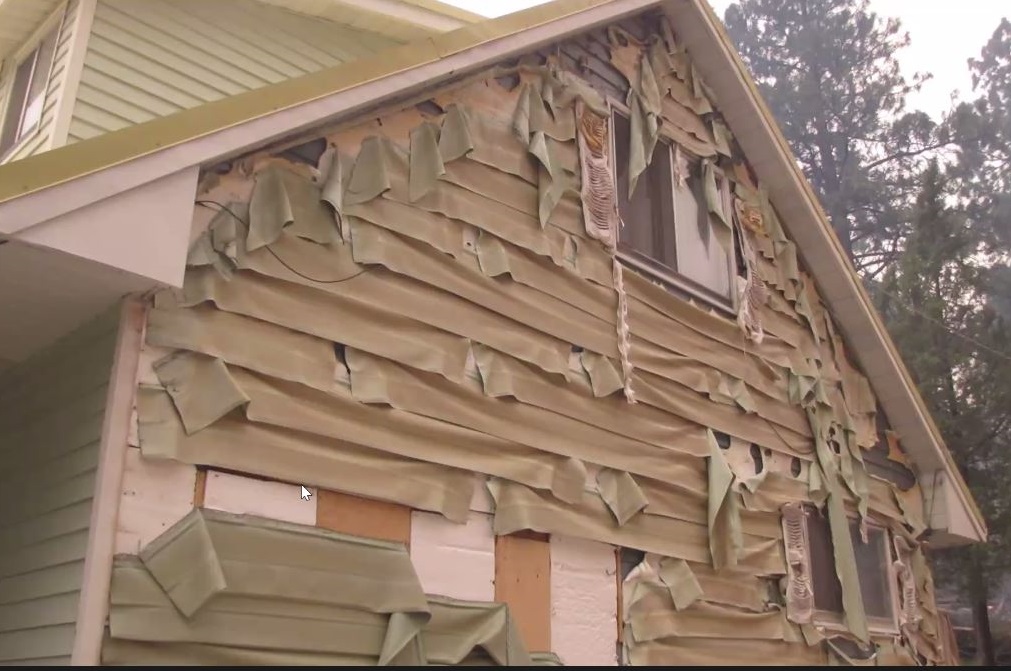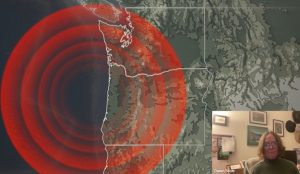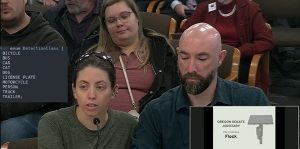Harden your home against ember wash
5 min read
Vinyl siding melted in the heat from a wildfire, making the home more vulnerable to ember wash. (Irene Jerome presentation)
The message from OSU’s Wildfire Wednesday: Don’t let open flame touch the house. Grant County Firewise coordinator Irene Jerome.
[00:00:09] Irene Jerome: I work for Grant County in Oregon, which is, John Day / Canyon City is the epicenter, if you will, if that’ll help you locate where I am. I’ve been doing it for quite a long time.
[00:00:19] So when we think about the home ignition zone you need to remember that your home itself is fuel. It’s fuel and and that’s how fire would see it if it came along. So a property that my husband and I own, it’s got a metal roof. The foundation is tall, so there’s a lot of cement around it. We cut the grass all around it. We thinned the trees out, but the real weakness of this structure is those two decks. Ember wash— It’s amazing how powerful that is and how much destruction it causes. And that’s has me worried. It still does. So we don’t have much under the bottom deck. We try to keep that clean, but sometimes during the summer the main deck gets filled with clutter, which is not good if you have to have a fire person come out and the upper deck The soffits, the rafters aren’t boxed in and there’s some holes. So if you had a big conflagration— which we’ve had in that area, we’ve been evacuated.— And we had embers that washed in there, they could very, very easily burn that house down.
Thank you for supporting
local citizen journalism
[00:01:15] And we haven’t been able to get insurance on it because of where we’re located. So I’ll be very frank about it. I’m still struggling with what to do with. Especially that upper deck, the lower one, we can keep clean. We think treating the boards will help. It is wood, but treating it’ll help, but we’ll see.
[00:01:32] John Q: Irene said our efforts should be directed towards not letting open flame touch the home.
[00:01:37] Irene Jerome: You do not want anything that will allow open flame to touch your structure. And even though our house up there has concrete and it’s like three feet high, we still don’t want anything with open flame touching that home. I mean, it’s just absolutely critical. There’s nooks, there’s crannies sometimes there’ll be some sort of a looseness in the siding on the house. It’s extremely insidious. So, look at your home in that five foot ignition zone and just make sure that there’s no way that open flame could touch that house.
[00:02:09] One weakness, you’ll see a wooden fence. And that wooden fence is attached to the house. And as the Australians say, ‘If it’s attached to the house, it’s part of the house.’ And so that could actually burn that home down because the fire starts burning on that fence and it would burn right up to the house. It’s like a wick or a cord and that’s happened over and over and over in these fires we’ve had in the wildland-urban interface. Our suggestion was is okay, if you have a fire, you have to evacuate, just open that gate and leave the gate open so that you don’t have a trail of fuel to the home.
[00:02:42] John Q: Sent aloft by the fire, burning embers pose an insidious threat.
[00:02:48] Irene Jerome: Also subtle, subtle, subtle things are prone to that ember wash. I looked up and there we had a bird nest built next to that gutter. And yes, if you add a big ember wash, that bird nest could light on fire and burn that home down. It seems impossible, but,
[00:03:04] The Canyon Creek Complex fire, just one of the many homes that burned. The roof is on fire and it had either metal or comp, so the roof itself was some good material, but none of the trees are on fire. We had a lot of wooden bridges across Canyon Creek on fire, and nothing else is on fire. That’s ember wash that started that. Same thing up on the hill, another home I believe that burned. So it’s just, it’s so powerful and so insidious and hard to grasp, but the threat is very real. Just in case anyone has that, vinyl siding does not do well with fires.
[00:03:40] One of the things we also learned on the Canyon Creek Complex: Any kind of an open door or open bay in an outbuilding, in a woodshed, you need some way to enclose that—a tarp, it doesn’t have to be anything fancy—so that those embers don’t blow in. If you have a big wildfire with ember wash or any kind of a fire, another structure fire would do it, that little woodshed would get on fire and then the structure would be on fire, and when buildings start burning, they burn extremely hot. So then you get structure fires. Any way to close something up, like I said, just even a tarp would do, to prevent those embers from entering those open areas.
[00:04:17] John Q: She shared a story about an unlikely hazard—a flower planter.
[00:04:21] Irene Jerome: These are some of the lessons we’ve learned. These folks, they’d been evacuated for quite a while. Several days after the fire had passed through, they came back to their house and when they got up there, what they discovered was in that planter, it was wet, had petunias in it. There was open flame against the side of the home. And the embers had landed between that planter and the house and started a fire. You still wouldn’t want fire next to your home because something could get up under that siding and into the sheathing.
[00:04:51] One home was lost up there and that home was one where the landowner chose not to take the advice of home hardening from the firefighters. We did a little pilot project up there. I thought that was, ‘Proof’s in the pudding.’ The one house that chose not to do the work, burned down. The others were saved. Because of their due diligence, their homes survived.
[00:05:10] John Q: From OSU’s “Wildfire Wednesday,” Grant County Firewise Coordinator Irene Jerome. Harden your home against burning embers.



